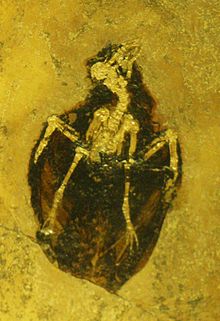- Cypselomorphae
-
Cypselomorphae 
Common Nighthawk, Chordeiles minor
(Caprimulgidae)
Male Rufous Hummingbird, Selasphorus rufus
(Trochilidae)Scientific classification Kingdom: Animalia Phylum: Chordata Class: Aves Subclass: Neornithes Infraclass: Neognathae Superorder: Neoaves (unranked): Cypselomorphae
Huxley, 1867Orders Apodiformes
Aegotheliformes
Caprimulgiformes (but see text)Cypselomorphae is a clade of birds. It includes the living families and orders Caprimulgidae (nightjars, nighthawks and allies), Nyctibiidae (potoos), Apodiformes (swifts and hummingbirds), as well as the Aegotheliformes (owlet-nightjars) whose distinctness was only recently realized. The Apodiformes (which include the "Trochiliformes" of the Sibley-Ahlquist taxonomy) and the Aegotheliformes form the Daedalornithes.[1]
In addition, several fossil taxa are tentatively placed here as basal or incertae sedis
- Eocypselus (Late Paleocene or Early Eocene)
- Paraprefica (Early Eocene?)
- Archaeotrogonidae (Early Eocene of England ?- Late Eocene/Early Oligocene of France)
- Hassiavis (Middle Eocene of Messel, Germany) - Archaeotrogonidae?
- Protocypselomorphus (Middle Eocene of Messel, Germany)
The relationships of the Early Eocene Parvicuculus and Procuculus from the southern North Sea basin are unresolved, but they bear some similarities to cypselomorphs.
The fossil evidence is quite consistent in this group. Over some 20 million years, throughout the Eocene, the present-day diversity (as well as some entirely extinct lineages) slowly unfolds. By mid-Oligocene, some 30 million years ago, the crown lineages are present and adapting to their present-day ecological niches.
By the distribution of fossils, the Paleogene radiation seems to have originated in Asia, which at that time became a highly fragmented landscape as the Himalayas lifted up and the Turgai Strait started to disappear.
The Cypselomorphae are part of the proposed Metaves. The material evidence for this group is very equivocal; the most ancient Cypselomorphae are quite nondescript tree-dwellers but already tend towards peculiarly apomorphic feet, and no Cretaceous fossils are known that would link them to other "Metaves" such as Mirandornithes.
Torpor and other metabolic peculiarities are very frequently found in this group, perhaps more often than in any other bird lineage.
Their shared apomorphies are: ossa maxillaria separated by a large cleft, a mandible with very short pars symphysialis, and rami mandibulae very slender in their distal half.
References
- ^ Sangster, G. (2005) A name for the clade formed by owlet-nightjars, swifts and hummingbirds (Aves). Zootaxa: 799:1-6.
Categories:
Wikimedia Foundation. 2010.

